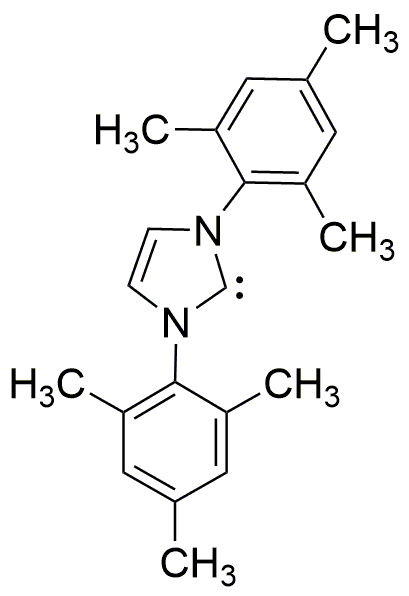1,3-Dimesitylimidazol-2-ylidene is widely utilized in research focused on:
- Catalysis: This compound serves as a highly effective ligand in various catalytic reactions, particularly in cross-coupling and C-H activation processes, enhancing reaction efficiency and selectivity.
- Organometallic Chemistry: It is used to stabilize metal complexes, improving the performance of catalysts in organic synthesis, which is crucial for the pharmaceutical and fine chemical industries.
- Material Science: The compound is applied in the development of advanced materials, such as polymers and nanomaterials, offering superior properties like thermal stability and mechanical strength.
- Medicinal Chemistry: Researchers leverage its unique structure to design new drugs, particularly in creating compounds that target specific biological pathways, enhancing therapeutic efficacy.
- Green Chemistry: Its application in sustainable processes helps reduce waste and energy consumption, aligning with the industry's shift towards environmentally friendly practices.
General Information
Properties
Safety and Regulations
Applications
1,3-Dimesitylimidazol-2-ylidene is widely utilized in research focused on:
- Catalysis: This compound serves as a highly effective ligand in various catalytic reactions, particularly in cross-coupling and C-H activation processes, enhancing reaction efficiency and selectivity.
- Organometallic Chemistry: It is used to stabilize metal complexes, improving the performance of catalysts in organic synthesis, which is crucial for the pharmaceutical and fine chemical industries.
- Material Science: The compound is applied in the development of advanced materials, such as polymers and nanomaterials, offering superior properties like thermal stability and mechanical strength.
- Medicinal Chemistry: Researchers leverage its unique structure to design new drugs, particularly in creating compounds that target specific biological pathways, enhancing therapeutic efficacy.
- Green Chemistry: Its application in sustainable processes helps reduce waste and energy consumption, aligning with the industry's shift towards environmentally friendly practices.
Documents
Safety Data Sheets (SDS)
The SDS provides comprehensive safety information on handling, storage, and disposal of the product.
Product Specification (PS)
The PS provides a comprehensive breakdown of the product’s properties, including chemical composition, physical state, purity, and storage requirements. It also details acceptable quality ranges and the product's intended applications.
Certificates of Analysis (COA)
Search for Certificates of Analysis (COA) by entering the products Lot Number. Lot and Batch Numbers can be found on a product’s label following the words ‘Lot’ or ‘Batch’.
*Catalog Number
*Lot Number
Certificates Of Origin (COO)
This COO confirms the country where the product was manufactured, and also details the materials and components used in it and whether it is derived from natural, synthetic, or other specific sources. This certificate may be required for customs, trade, and regulatory compliance.
*Catalog Number
*Lot Number
Safety Data Sheets (SDS)
The SDS provides comprehensive safety information on handling, storage, and disposal of the product.
DownloadProduct Specification (PS)
The PS provides a comprehensive breakdown of the product’s properties, including chemical composition, physical state, purity, and storage requirements. It also details acceptable quality ranges and the product's intended applications.
DownloadCertificates of Analysis (COA)
Search for Certificates of Analysis (COA) by entering the products Lot Number. Lot and Batch Numbers can be found on a product’s label following the words ‘Lot’ or ‘Batch’.
*Catalog Number
*Lot Number
Certificates Of Origin (COO)
This COO confirms the country where the product was manufactured, and also details the materials and components used in it and whether it is derived from natural, synthetic, or other specific sources. This certificate may be required for customs, trade, and regulatory compliance.


